Analysis of Risk Management: Capital and Leverage Regulation Reforms
VerifiedAdded on 2023/04/22
|6
|1117
|138
Report
AI Summary
This report provides an in-depth assessment of capital and leverage regulations implemented following the global financial crisis. It examines the significance of Basel III, including its enhanced capital quality requirements, liquidity provisions like LCR and NSFR, and measures to prevent hig...
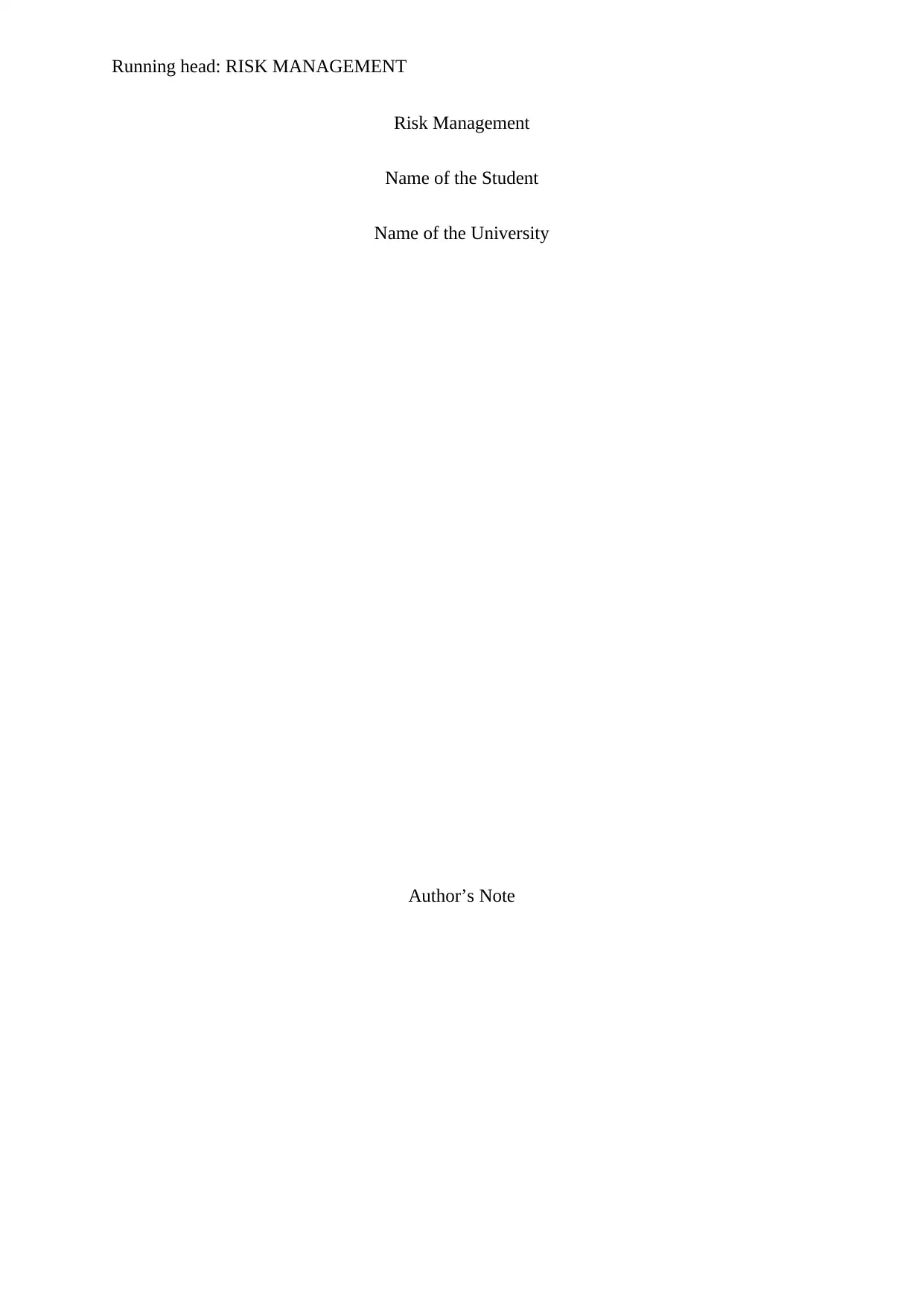
Running head: RISK MANAGEMENT
Risk Management
Name of the Student
Name of the University
Author’s Note
Risk Management
Name of the Student
Name of the University
Author’s Note
Paraphrase This Document
Need a fresh take? Get an instant paraphrase of this document with our AI Paraphraser
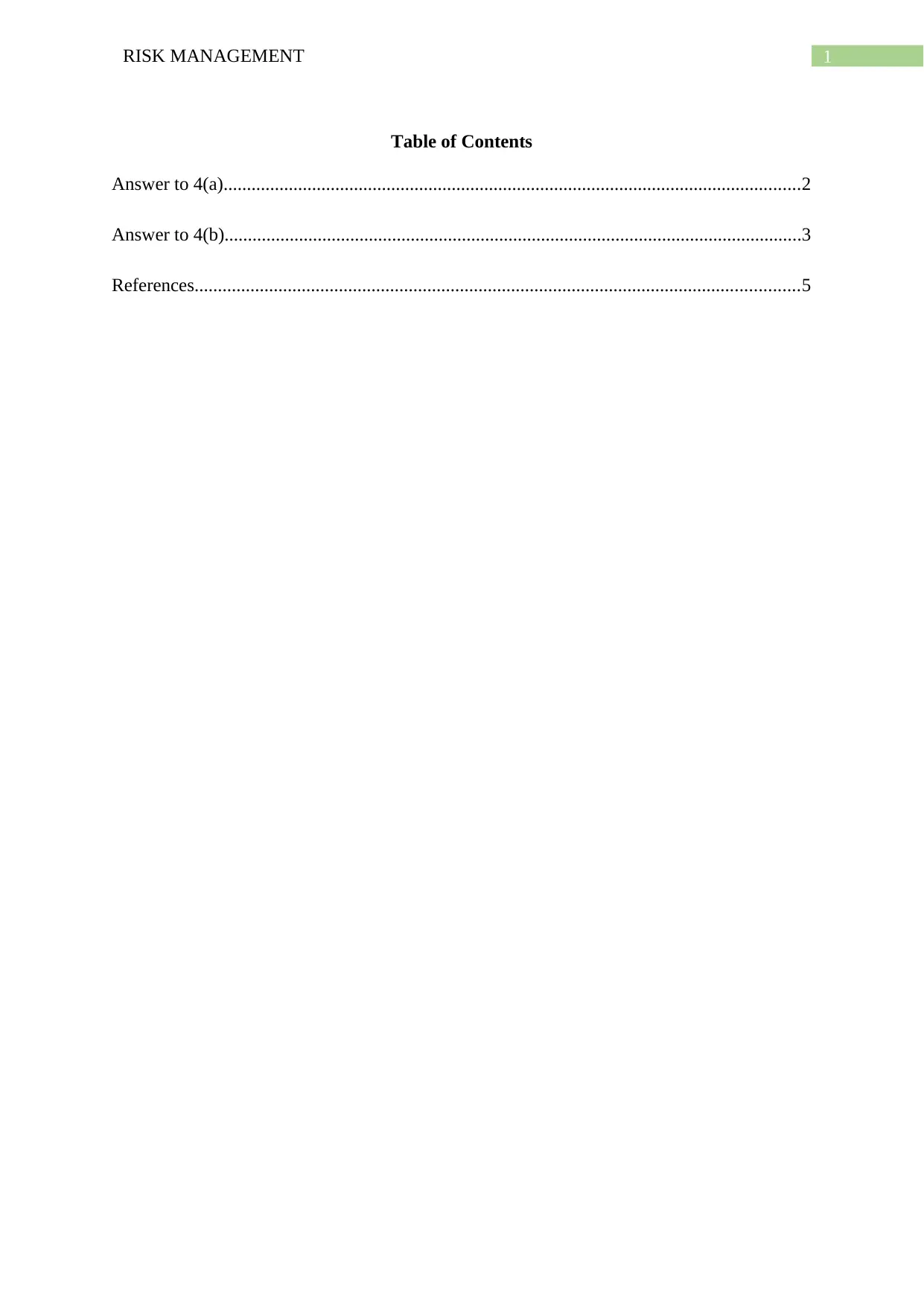
1RISK MANAGEMENT
Table of Contents
Answer to 4(a)............................................................................................................................2
Answer to 4(b)............................................................................................................................3
References..................................................................................................................................5
Table of Contents
Answer to 4(a)............................................................................................................................2
Answer to 4(b)............................................................................................................................3
References..................................................................................................................................5
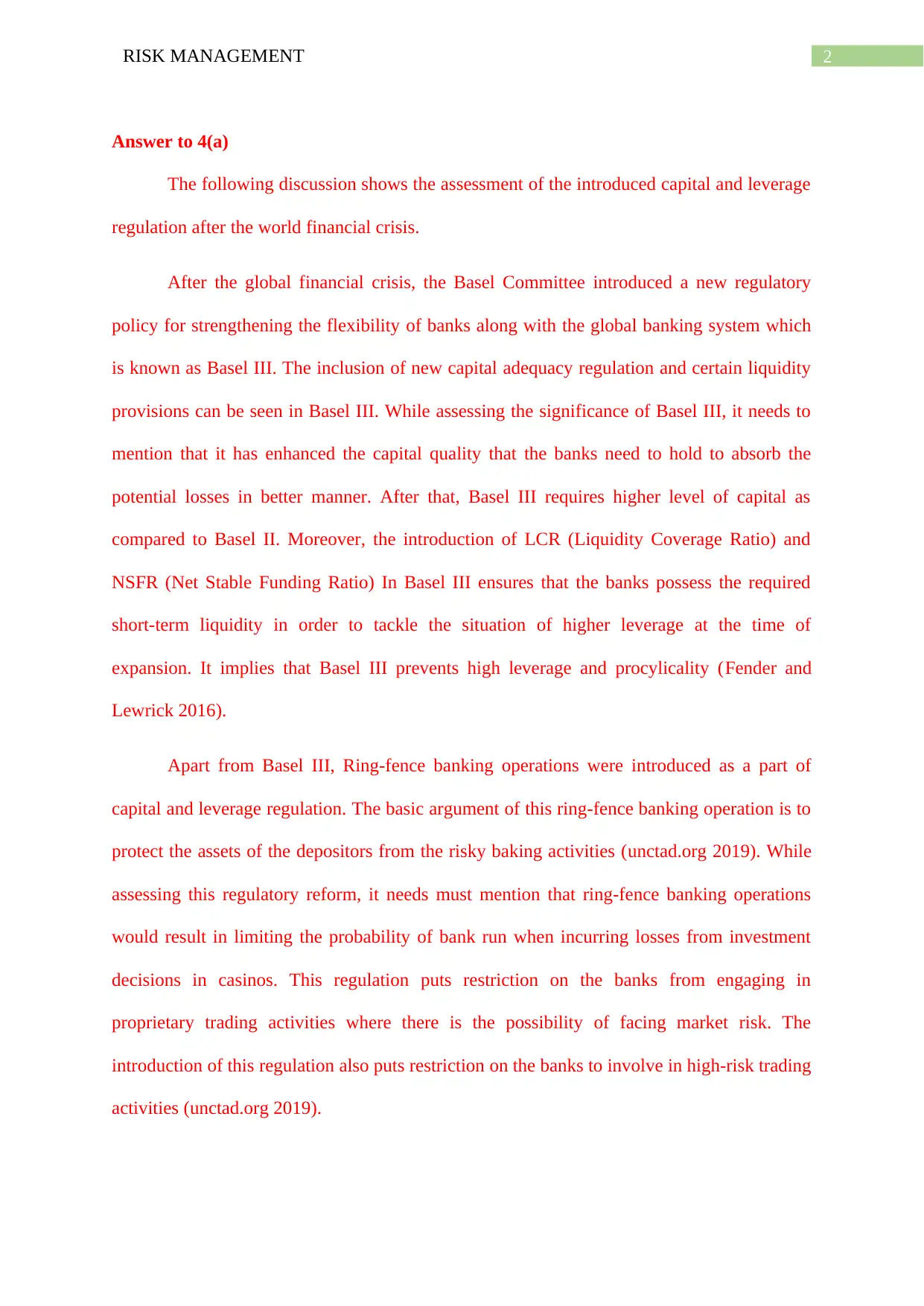
2RISK MANAGEMENT
Answer to 4(a)
The following discussion shows the assessment of the introduced capital and leverage
regulation after the world financial crisis.
After the global financial crisis, the Basel Committee introduced a new regulatory
policy for strengthening the flexibility of banks along with the global banking system which
is known as Basel III. The inclusion of new capital adequacy regulation and certain liquidity
provisions can be seen in Basel III. While assessing the significance of Basel III, it needs to
mention that it has enhanced the capital quality that the banks need to hold to absorb the
potential losses in better manner. After that, Basel III requires higher level of capital as
compared to Basel II. Moreover, the introduction of LCR (Liquidity Coverage Ratio) and
NSFR (Net Stable Funding Ratio) In Basel III ensures that the banks possess the required
short-term liquidity in order to tackle the situation of higher leverage at the time of
expansion. It implies that Basel III prevents high leverage and procylicality (Fender and
Lewrick 2016).
Apart from Basel III, Ring-fence banking operations were introduced as a part of
capital and leverage regulation. The basic argument of this ring-fence banking operation is to
protect the assets of the depositors from the risky baking activities (unctad.org 2019). While
assessing this regulatory reform, it needs must mention that ring-fence banking operations
would result in limiting the probability of bank run when incurring losses from investment
decisions in casinos. This regulation puts restriction on the banks from engaging in
proprietary trading activities where there is the possibility of facing market risk. The
introduction of this regulation also puts restriction on the banks to involve in high-risk trading
activities (unctad.org 2019).
Answer to 4(a)
The following discussion shows the assessment of the introduced capital and leverage
regulation after the world financial crisis.
After the global financial crisis, the Basel Committee introduced a new regulatory
policy for strengthening the flexibility of banks along with the global banking system which
is known as Basel III. The inclusion of new capital adequacy regulation and certain liquidity
provisions can be seen in Basel III. While assessing the significance of Basel III, it needs to
mention that it has enhanced the capital quality that the banks need to hold to absorb the
potential losses in better manner. After that, Basel III requires higher level of capital as
compared to Basel II. Moreover, the introduction of LCR (Liquidity Coverage Ratio) and
NSFR (Net Stable Funding Ratio) In Basel III ensures that the banks possess the required
short-term liquidity in order to tackle the situation of higher leverage at the time of
expansion. It implies that Basel III prevents high leverage and procylicality (Fender and
Lewrick 2016).
Apart from Basel III, Ring-fence banking operations were introduced as a part of
capital and leverage regulation. The basic argument of this ring-fence banking operation is to
protect the assets of the depositors from the risky baking activities (unctad.org 2019). While
assessing this regulatory reform, it needs must mention that ring-fence banking operations
would result in limiting the probability of bank run when incurring losses from investment
decisions in casinos. This regulation puts restriction on the banks from engaging in
proprietary trading activities where there is the possibility of facing market risk. The
introduction of this regulation also puts restriction on the banks to involve in high-risk trading
activities (unctad.org 2019).
⊘ This is a preview!⊘
Do you want full access?
Subscribe today to unlock all pages.

Trusted by 1+ million students worldwide
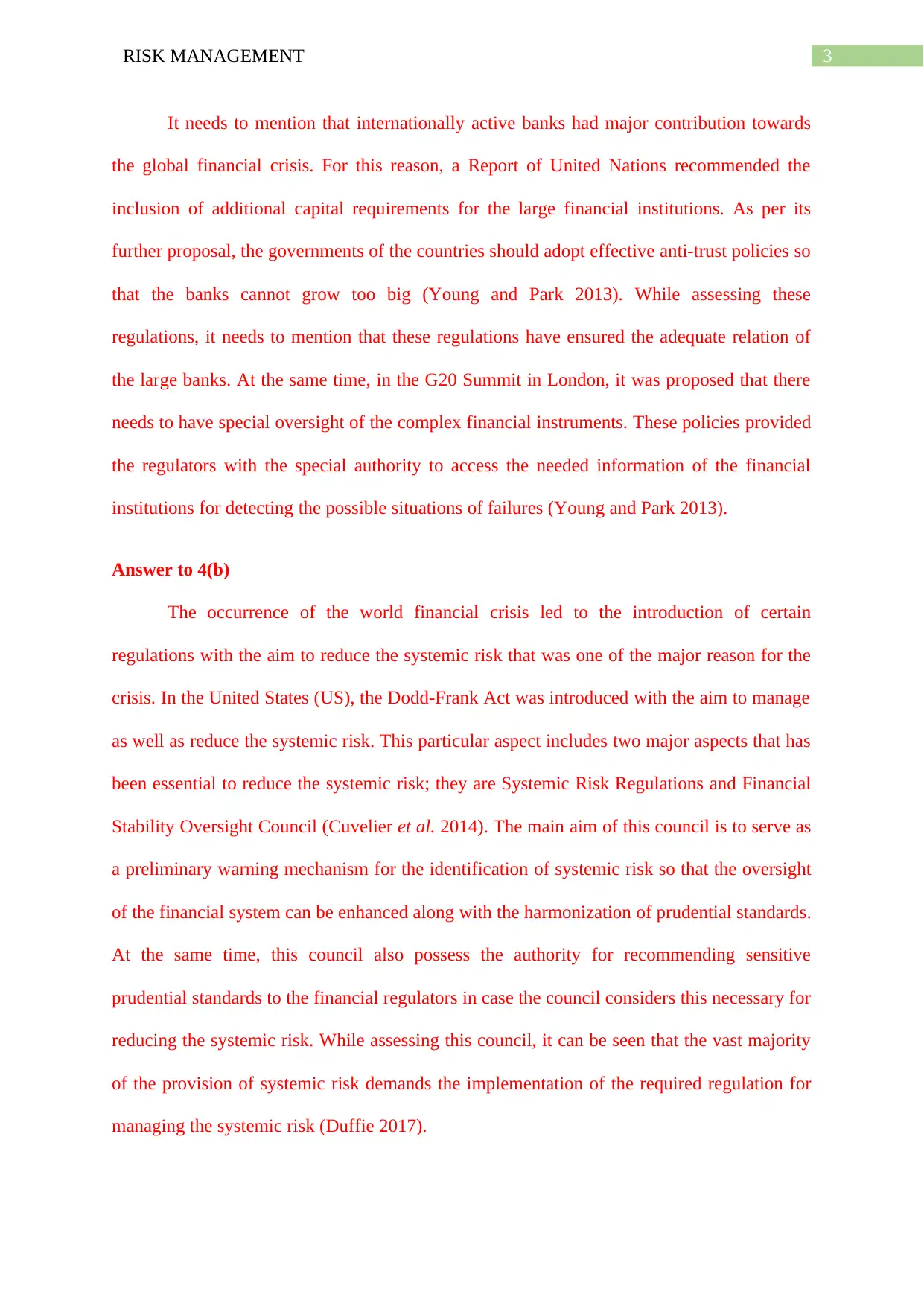
3RISK MANAGEMENT
It needs to mention that internationally active banks had major contribution towards
the global financial crisis. For this reason, a Report of United Nations recommended the
inclusion of additional capital requirements for the large financial institutions. As per its
further proposal, the governments of the countries should adopt effective anti-trust policies so
that the banks cannot grow too big (Young and Park 2013). While assessing these
regulations, it needs to mention that these regulations have ensured the adequate relation of
the large banks. At the same time, in the G20 Summit in London, it was proposed that there
needs to have special oversight of the complex financial instruments. These policies provided
the regulators with the special authority to access the needed information of the financial
institutions for detecting the possible situations of failures (Young and Park 2013).
Answer to 4(b)
The occurrence of the world financial crisis led to the introduction of certain
regulations with the aim to reduce the systemic risk that was one of the major reason for the
crisis. In the United States (US), the Dodd-Frank Act was introduced with the aim to manage
as well as reduce the systemic risk. This particular aspect includes two major aspects that has
been essential to reduce the systemic risk; they are Systemic Risk Regulations and Financial
Stability Oversight Council (Cuvelier et al. 2014). The main aim of this council is to serve as
a preliminary warning mechanism for the identification of systemic risk so that the oversight
of the financial system can be enhanced along with the harmonization of prudential standards.
At the same time, this council also possess the authority for recommending sensitive
prudential standards to the financial regulators in case the council considers this necessary for
reducing the systemic risk. While assessing this council, it can be seen that the vast majority
of the provision of systemic risk demands the implementation of the required regulation for
managing the systemic risk (Duffie 2017).
It needs to mention that internationally active banks had major contribution towards
the global financial crisis. For this reason, a Report of United Nations recommended the
inclusion of additional capital requirements for the large financial institutions. As per its
further proposal, the governments of the countries should adopt effective anti-trust policies so
that the banks cannot grow too big (Young and Park 2013). While assessing these
regulations, it needs to mention that these regulations have ensured the adequate relation of
the large banks. At the same time, in the G20 Summit in London, it was proposed that there
needs to have special oversight of the complex financial instruments. These policies provided
the regulators with the special authority to access the needed information of the financial
institutions for detecting the possible situations of failures (Young and Park 2013).
Answer to 4(b)
The occurrence of the world financial crisis led to the introduction of certain
regulations with the aim to reduce the systemic risk that was one of the major reason for the
crisis. In the United States (US), the Dodd-Frank Act was introduced with the aim to manage
as well as reduce the systemic risk. This particular aspect includes two major aspects that has
been essential to reduce the systemic risk; they are Systemic Risk Regulations and Financial
Stability Oversight Council (Cuvelier et al. 2014). The main aim of this council is to serve as
a preliminary warning mechanism for the identification of systemic risk so that the oversight
of the financial system can be enhanced along with the harmonization of prudential standards.
At the same time, this council also possess the authority for recommending sensitive
prudential standards to the financial regulators in case the council considers this necessary for
reducing the systemic risk. While assessing this council, it can be seen that the vast majority
of the provision of systemic risk demands the implementation of the required regulation for
managing the systemic risk (Duffie 2017).
Paraphrase This Document
Need a fresh take? Get an instant paraphrase of this document with our AI Paraphraser
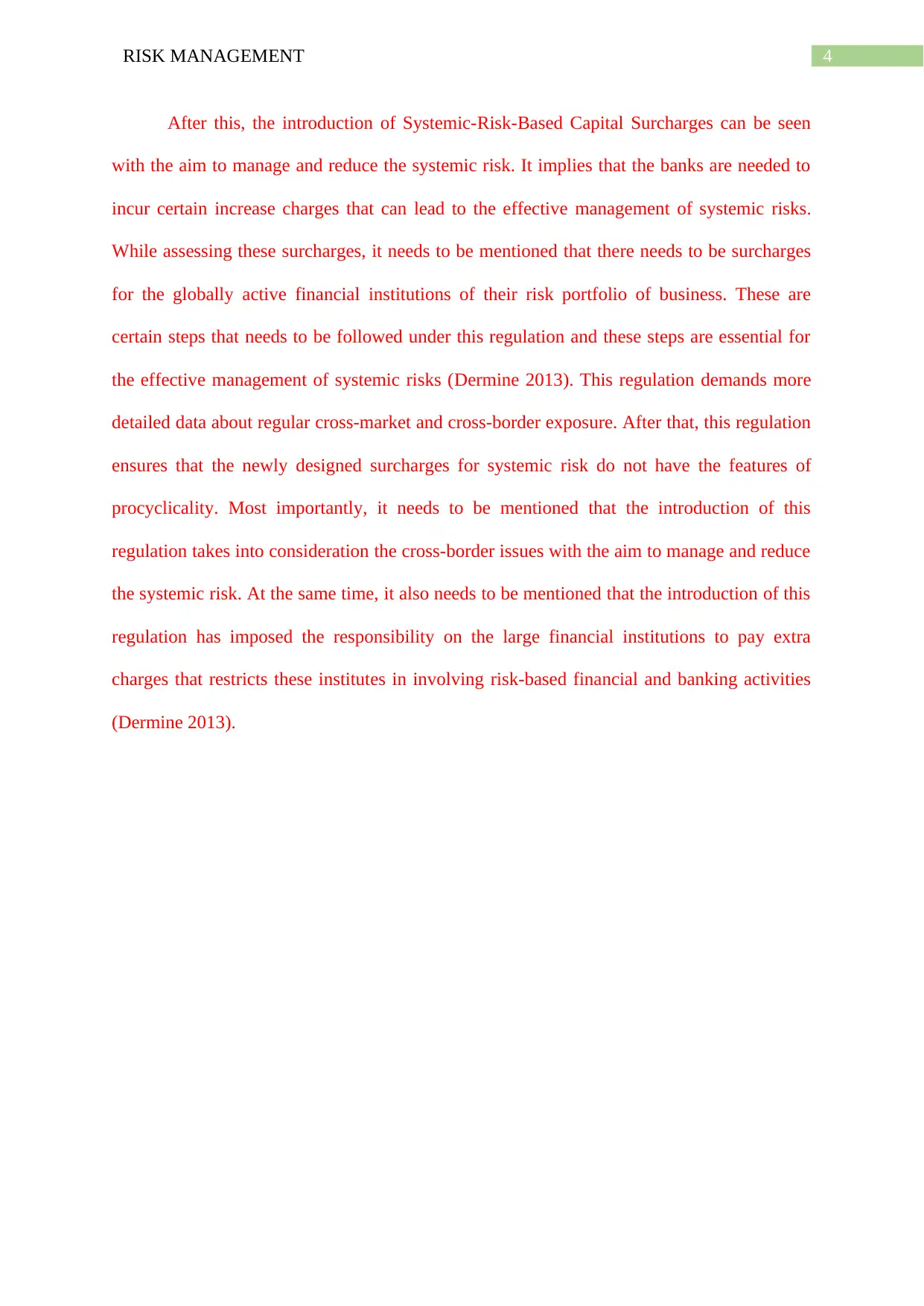
4RISK MANAGEMENT
After this, the introduction of Systemic-Risk-Based Capital Surcharges can be seen
with the aim to manage and reduce the systemic risk. It implies that the banks are needed to
incur certain increase charges that can lead to the effective management of systemic risks.
While assessing these surcharges, it needs to be mentioned that there needs to be surcharges
for the globally active financial institutions of their risk portfolio of business. These are
certain steps that needs to be followed under this regulation and these steps are essential for
the effective management of systemic risks (Dermine 2013). This regulation demands more
detailed data about regular cross-market and cross-border exposure. After that, this regulation
ensures that the newly designed surcharges for systemic risk do not have the features of
procyclicality. Most importantly, it needs to be mentioned that the introduction of this
regulation takes into consideration the cross-border issues with the aim to manage and reduce
the systemic risk. At the same time, it also needs to be mentioned that the introduction of this
regulation has imposed the responsibility on the large financial institutions to pay extra
charges that restricts these institutes in involving risk-based financial and banking activities
(Dermine 2013).
After this, the introduction of Systemic-Risk-Based Capital Surcharges can be seen
with the aim to manage and reduce the systemic risk. It implies that the banks are needed to
incur certain increase charges that can lead to the effective management of systemic risks.
While assessing these surcharges, it needs to be mentioned that there needs to be surcharges
for the globally active financial institutions of their risk portfolio of business. These are
certain steps that needs to be followed under this regulation and these steps are essential for
the effective management of systemic risks (Dermine 2013). This regulation demands more
detailed data about regular cross-market and cross-border exposure. After that, this regulation
ensures that the newly designed surcharges for systemic risk do not have the features of
procyclicality. Most importantly, it needs to be mentioned that the introduction of this
regulation takes into consideration the cross-border issues with the aim to manage and reduce
the systemic risk. At the same time, it also needs to be mentioned that the introduction of this
regulation has imposed the responsibility on the large financial institutions to pay extra
charges that restricts these institutes in involving risk-based financial and banking activities
(Dermine 2013).
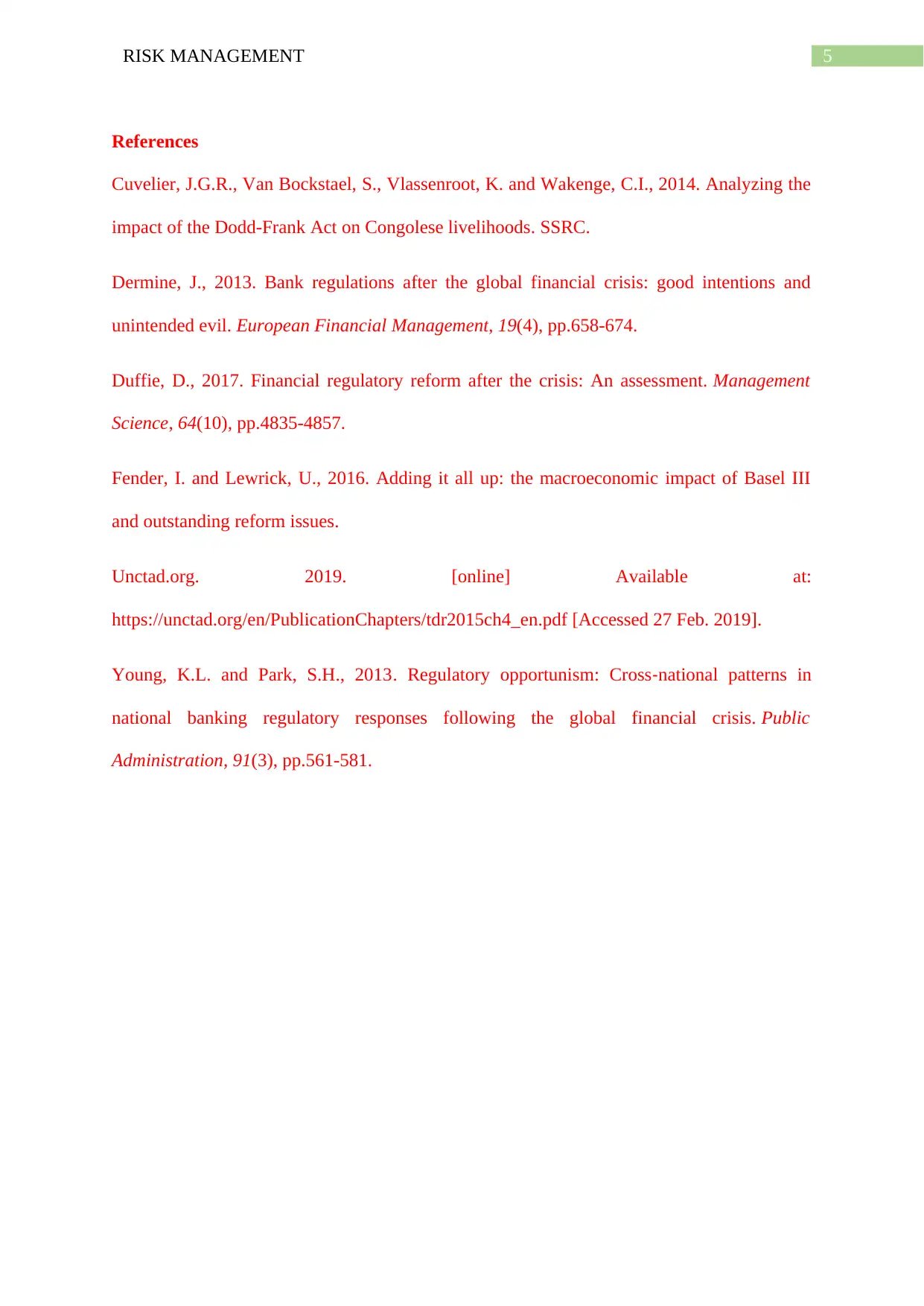
5RISK MANAGEMENT
References
Cuvelier, J.G.R., Van Bockstael, S., Vlassenroot, K. and Wakenge, C.I., 2014. Analyzing the
impact of the Dodd-Frank Act on Congolese livelihoods. SSRC.
Dermine, J., 2013. Bank regulations after the global financial crisis: good intentions and
unintended evil. European Financial Management, 19(4), pp.658-674.
Duffie, D., 2017. Financial regulatory reform after the crisis: An assessment. Management
Science, 64(10), pp.4835-4857.
Fender, I. and Lewrick, U., 2016. Adding it all up: the macroeconomic impact of Basel III
and outstanding reform issues.
Unctad.org. 2019. [online] Available at:
https://unctad.org/en/PublicationChapters/tdr2015ch4_en.pdf [Accessed 27 Feb. 2019].
Young, K.L. and Park, S.H., 2013. Regulatory opportunism: Cross‐national patterns in
national banking regulatory responses following the global financial crisis. Public
Administration, 91(3), pp.561-581.
References
Cuvelier, J.G.R., Van Bockstael, S., Vlassenroot, K. and Wakenge, C.I., 2014. Analyzing the
impact of the Dodd-Frank Act on Congolese livelihoods. SSRC.
Dermine, J., 2013. Bank regulations after the global financial crisis: good intentions and
unintended evil. European Financial Management, 19(4), pp.658-674.
Duffie, D., 2017. Financial regulatory reform after the crisis: An assessment. Management
Science, 64(10), pp.4835-4857.
Fender, I. and Lewrick, U., 2016. Adding it all up: the macroeconomic impact of Basel III
and outstanding reform issues.
Unctad.org. 2019. [online] Available at:
https://unctad.org/en/PublicationChapters/tdr2015ch4_en.pdf [Accessed 27 Feb. 2019].
Young, K.L. and Park, S.H., 2013. Regulatory opportunism: Cross‐national patterns in
national banking regulatory responses following the global financial crisis. Public
Administration, 91(3), pp.561-581.
⊘ This is a preview!⊘
Do you want full access?
Subscribe today to unlock all pages.

Trusted by 1+ million students worldwide
1 out of 6
Related Documents
Your All-in-One AI-Powered Toolkit for Academic Success.
+13062052269
info@desklib.com
Available 24*7 on WhatsApp / Email
![[object Object]](/_next/static/media/star-bottom.7253800d.svg)
Unlock your academic potential
© 2024 | Zucol Services PVT LTD | All rights reserved.





